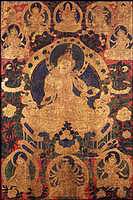
|
Tutelary Deity (painting no. 114)
|

View Larger Image |
||||||||||||||
|
Sita Vajravidarana, (Tibetan: dor je nam par jom pa kar po, English: The White One who Completely Destroys). With one face and two hands, the right hand holds a visvavajra (double crossed vajra) to the heart and the left a vajra handled bell against the left hip with the opening turned up. Showing a slightly fierce expression he has three eyes, adorned with a crown, jewels and silk garments. Seated in vajra posture he is surrounded by the flames of pristine awareness. At the top center is the Lord Tsongkhapa in his characteristic iconographic form with the hands performing the 'Dharma teaching' mudra holding two lotus stems at the heart supporting the sword of wisdom and the Prajnaparamita sutra on the blossoms. He wears the hat of a pandita with the characteristic point typical of the Gelugpa School. To the left is Avalokiteshvara, white, with four hands and 'Stupa of Enlightenment' in the left corner. At the right is Vajrapani, wrathful, with two hands. In the right corner is the buddha Akshobhya performing the earth touching mudra with the right hand and holding an upright vajra in the left. At the bottom center is Maha Pratisara (Tib.: So sor trang ma), yellow in colour with three faces and ten hands. She is the leader of the famous set of five great goddesses known as the 'Maha Panca Devi.' On the bottom right is Maha Sitavani, red in colour with four hands. To the bottom left is Maha Mayuri, green, with one face and two hands. Above, on the left is Maha Sahasrapramardana, blue in colour with one face and six hands. Again on the right side is Maha Mantramanudharani, black in colour with one face and four hands. This set of 'Five Goddesses' is drawn according to the system of Lord Atisha who founded the Kadampa School of Buddhism in the 11th century. The Style of painting is called 'ser thang.' From a background of red the figures are drawn and filled with gold. Red, white and black pigments are used only for lips, eyes and hair. Dark blue and green pigments are used for the throne, Chinese style lotus blossoms, foliage and the nimbus of the figures. The names of all the figures are written in gold with fine brush strokes. J.Watt 5-98
|
|||||||||||||||
Photographed Image Copyright © 1999 Shelley & Donald Rubin Foundation
|
|
| |
Next Image |